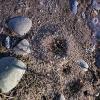Hello, welcome to the forum (Haha haven't said that for a while)
I'm located in Richmond, the city south of Vancouver. I don't know all the ants in the greater Vancouver area and even more so about their specific biologies but the climate here is rather consistent so I doubt there will be too much variation in diversity. but the the most common ants in an urbanized environment found here are Tetramorium, Lasius, Formica , Camponotus, Myrmica, Tapinoma sessile,and Leptothorax
The best starter species here are Lasius alienus and Tetramorium sp. e. They're very easy to care for and rear, Tetramorium especially so, they're not picky eaters, very resilient to just about everything and don't tend to die off easily if you mess up. You can keep them just about anywhere with a bit of hydration and they'll lay eggs.
Lasius queens tend to rear their young and settle down quickly. I wouldn't advise putting them in the light but as long as they're in a dark place with good hydration they should do fine.
Both of these species grow pretty fast. Tetramorium start flying in early June and mid stop around the end of July, early in the mornings. Lasius usually fly after rain and during the evening. And usually start flying from late June to the end of July.
Lasius are really good climbers and most DIY barriers besides lids have a chance of failing. Fluon is best.
I've personally have very little experience with Formica let alone success. They tend to be very sensitive ants and I'm afraid I don't have any good advice when it comes to these. Just keep in mind Formica tend to spray acid so any nest they live in should be decently ventilated. Queens are fully claustral and most species fly during the summer. This is the most diverse genus in BC. Just don't try to bother them as much basically.
Camponotus have a reputation for being slow growers, both Camponotus modoc and Camponotus novaeboracensis are present here but Camponotus novaeboracensis is almost absent in urban environments. Camponotus modoc however are very widespread. In turns of rearing Camponotus modoc, just keep the queen in a quiet and dark place and do nothing, Camponotus are a lot more sensitive to vibrations and light especially in the founding stage. Although they have the reputation for being easy ants a lot of Camponotus problems don't happen during founding but rather when the colony reaches it's 2nd or 3rd year where they just end up stalling. A senior member here, Crystals noted that Camponotus that hibernated in areas where no snow occurred usually faced this problem. I don't think anyone has found a definite answer to why some colonies fail and others don't. They are rather dry loving ants and require are best with a varied diet. Both of these species fly during May.
There are a few Myrmica species in the greater Vancouver area, threeish native species (M. incompleta, M. brevispinosa and another Myrmica sp.) , and twoish invasives (Myrmica cf. specioides and Myrmica rubra). Most of the native species aren't found in urban areas. Burnaby is one of the places with M. rubra (AKA the European fire ant) is present but because of their invasive and destructive status and the cities giving a darn obtaining one is hard and probably not a great idea. Queens mate in the nest and colonies split by budding. Unlikely you will find a queen above ground. They are regarded as good starter species though despite stinging everything.
Myrmica cf. specioides is much more widespread and far less destructive. Like most Myrmica they're semi-claustral and so you will need to provide her with an area to forage. Other then the founding stage M. cf. specioides doesn't have any special requirements. They also don't sting as much or hardly.
Most of the other ants aren't very easy.
TL;DR Lasius alienus and Tetramorium are the best. Formica are a bit more sensitive so don't bother them too much, most diverse genus in BC. Camponotus requires a lot of patience and might be finicky eaters. Myrmica are semi-claustral.
![]()
![]()
![]()


















